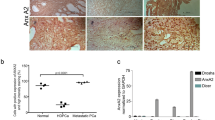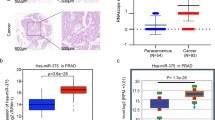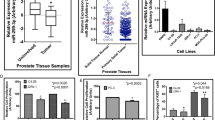Abstract
The androgen receptor (AR) signaling pathway is involved in the emergence of castration-resistant prostate cancer (CRPC). Here, we identified several androgen-regulated microRNAs (miRNAs) that may contribute to the development of CRPC. Seven miRNAs, miR-21, miR-32, miR-99a, miR-99b, miR-148a, miR-221 and miR-590-5p, were found to be differentially expressed in CRPC compared with benign prostate hyperplasia (BPH) according to microarray analyses. Significant growth advantage for LNCaP cells transfected with pre-miR-32 and pre-miR-148a was found. miR-32 was demonstrated to reduce apoptosis, whereas miR-148a enhanced proliferation. Androgen regulation of miR-32 and miR-148a was confirmed by androgen stimulation of the LNCaP cells followed by expression analyses. The AR-binding sites in proximity of these miRNAs were demonstrated with chromatin immunoprecipitation (ChIP). To identify target genes for the miRNAs, mRNA microarray analyses were performed with LNCaP cells transfected with pre-miR-32 and pre-miR-148a. Expression of BTG2 and PIK3IP1 was reduced in the cells transfected with pre-miR-32 and pre-miR-148a, respectively. Also, the protein expression was reduced according to western blot analysis. BTG2 and PIK3IP1 were confirmed to be targets by 3′UTR-luciferase assays. Finally, immunostainings showed a statistically significant (P<0.0001) reduction of BTG2 protein in CRPCs compared with untreated prostate cancer (PC). The lack of BTG2 staining was also associated (P<0.01) with a short progression-free time in patients who underwent prostatectomy. In conclusion, androgen-regulated miR-32 is overexpressed in CRPC, leading to reduced expression of BTG2. Thus, miR-32 is a potential marker for aggressive disease and is a putative drug target in PC.
This is a preview of subscription content, access via your institution
Access options
Subscribe to this journal
Receive 50 print issues and online access
$259.00 per year
only $5.18 per issue
Buy this article
- Purchase on Springer Link
- Instant access to full article PDF
Prices may be subject to local taxes which are calculated during checkout





Similar content being viewed by others

Accession codes
References
Ambs S, Prueitt RL, Yi M, Hudson RS, Howe TM, Petrocca F et al. (2008). Genomic profiling of microRNA and messenger RNA reveals deregulated microRNA expression in prostate cancer. Cancer Res 68: 6162–6170.
Attard G, Reid AH, Yap TA, Raynaud F, Dowsett M, Settatree S et al. (2008). Phase I clinical trial of a selective inhibitor of CYP17, abiraterone acetate, confirms that castration-resistant prostate cancer commonly remains hormone driven. J Clin Oncol 26: 4563–4571.
Bartel DP . (2009). MicroRNAs: target recognition and regulatory functions. Cell 136: 215–233.
Cai C, Wang H, Xu Y, Chen S, Balk SP . (2009). Reactivation of androgen receptor-regulated TMPRSS2:ERG gene expression in castration-resistant prostate cancer. Cancer Res 69: 6027–6032.
Chen CD, Welsbie DS, Tran C, Baek SH, Chen R, Vessella R et al. (2004). Molecular determinants of resistance to antiandrogen therapy. Nat Med 10: 33–39.
Courtney KD, Corcoran RB, Engelman JA . (2010). The PI3K pathway as drug target in human cancer. J Clin Oncol 28: 1075–1083.
Di Leva G, Croce CM . (2010). Roles of small RNAs in tumor formation. Trends Mol Med 16: 257–267.
Edwards J, Krishna NS, Grigor KM, Bartlett JM . (2003). Androgen receptor gene amplification and protein expression in hormone refractory prostate cancer. Br J Cancer 89: 552–526.
Feldman BJ, Feldman D . (2001). The development of androgen-independent prostate cancer. Nat Rev Cancer 1: 34–45.
Ficazzola MA, Fraiman M, Gitlin J, Woo K, Melamed J, Rubin MA et al. (2001). Antiproliferative B cell translocation gene 2 protein is down-regulated post-transcriptionally as an early event in prostate carcinogenesis. Carcinogenesis 22: 1271–1279.
Friedman RC, Farh KK, Burge CB, Bartel DP . (2009). Most mammalian mRNAs are conserved targets of microRNAs. Genome Res 19: 92–105.
Fujita Y, Kojima K, Ohhashi R, Hamada N, Nozawa Y, Kitamoto A et al. (2010). MiR-148a attenuates paclitaxel resistance of hormone-refractory, drug-resistant prostate cancer PC3 cells by regulating MSK1 expression. J Biol Chem 285: 19076–19084.
Guo H, Ingolia NT, Weissman JS, Bartel DP . (2010). Mammalian microRNAs predominantly act to decrease target mRNA levels. Nature 466: 835–840.
Hong JW, Ryu MS, Lim IK . (2005). Phosphorylation of serine 147 of tis21/BTG2/pc3 by p-Erk1/2 induces Pin-1 binding in cytoplasm and cell death. J Biol Chem 280: 21256–21263.
Hu XD, Meng QH, Xu JY, Jiao Y, Ge CM, Jacob A et al. (2011). BTG2 is an LXXLL-dependent co-repressor for androgen receptor transcriptional activity. Biochem Biophys Res Commun 404: 903–909.
Jalava SE, Porkka KP, Rauhala HE, Isotalo J, Tammela TL, Visakorpi T . (2009). TCEB1 promotes invasion of prostate cancer cells. Int J Cancer 124: 95–102.
Karvonen U, Kallio PJ, Jänne OA, Palvimo JJ . (1997). Interaction of androgen receptors with androgen response element in intact cells. J Biol Chem 272: 15973–15979.
Kloosterman WP, Plasterk RH . (2006). The diverse functions of microRNAs in animal development and disease. Dev Cell 11: 441–450.
Langmead B, Trapnell C, Pop M, Salzberg SL . (2009). Ultrafast and memory-efficient alignment of short DNA sequences to the human genome. Genome Biol 10: R25.
Leinonen KA, Tolonen TT, Bracken H, Stenman UH, Tammela TL, Saramäki OR et al. (2010). Association of SPINK1 expression and TMPRSS2:ERG fusion with prognosis in endocrine-treated prostate cancer. Clin Cancer Res 16: 2845–2851.
Linja MJ, Savinainen KJ, Saramäki OR, Tammela TL, Vessella RL, Visakorpi T . (2001). Amplification and overexpression of androgen receptor gene in hormone-refractory prostate cancer. Cancer Res 61: 3550–3555.
Lu J, Getz G, Miska EA, Alvarez-Saavedra E, Lamb J, Peck D et al. (2005). MicroRNA expression profiles classify human cancers. Nature 435: 834–838.
Martens-Uzunova ES, Jalava SE, Dits NF, van Leenders GJLH, Møller S, Trapman J et al. (2011). Diagnostic and prognostic signatures from the small non-coding RNA transcriptome in prostate cancer. Oncogene 31: 978–991.
Massard C, Fizazi K . (2011). Targeting continued androgen receptor signaling in prostate cancer. Clin Cancer Res 17: 3876–3883.
Möllerström E, Kovács A, Lövgren K, Nemes S, Delle U, Danielsson A et al. (2010). Up-regulation of cell cycle arrest protein BTG2 correlates with increased overall survival in breast cancer, as detected by immunohistochemistry using tissue microarray. BMC Cancer 10: 296.
Murata T, Takayama K, Katayama S, Urano T, Horie-Inoue K, Ikeda K et al. (2010). miR-148a is an androgen-responsive microRNA that promotes LNCaP prostate cell growth by repressing its target CAND1 expression. Prostate Cancer Prostatic Dis 13: 356–361.
Porkka KP, Pfeiffer MJ, Waltering KK, Vessella RL, Tammela TL, Visakorpi T . (2007). MicroRNA expression profiling in prostate cancer. Cancer Res 67: 6130–6135.
Ribas J, Ni X, Haffner M, Wentzel EA, Salmasi AH, Chowdhury WH et al. (2009). miR-21: an androgen receptor-regulated microRNA that promotes hormone-dependent and hormone-independent prostate cancer growth. Cancer Res 69: 7165–7169.
Sahu B, Laakso M, Ovaska K, Mirtti T, Lundin J, Rannikko A et al. (2011). Dual role of FoxA1 in androgen receptor binding to chromatin, androgen signalling and prostate cancer. EMBO J 30: 3962–3976.
Sandberg R, Neilson JR, Sarma A, Sharp PA, Burge CB . (2008). Proliferating cells express mRNAs with shortened 3′ untranslated regions and fewer microRNA target sites. Science 320: 1643–1647.
Saramäki OR, Harjula AE, Martikainen PM, Vessella RL, Tammela TL, Visakorpi T . (2008). TMPRSS2:ERG fusion identifies a subgroup of prostate cancers with a favorable prognosis. Clin Cancer Res 14: 3395–3400.
Schaefer A, Jung M, Mollenkopf HJ, Wagner I, Stephan C, Jentzmik F et al. (2010). Diagnostic and prognostic implications of microRNA profiling in prostate carcinoma. Int J Cancer 126: 1166–1176.
Scher HI, Sawyers CL . (2005). Biology of progressive, castration-resistant prostate cancer: directed therapies targeting the androgen-receptor signaling axis. J Clin Oncol 23: 8253–8261.
Spahn M, Kneitz S, Scholz CJ, Stenger N, Rüdiger T, Ströbel P et al. (2010). Expression of microRNA-221 is progressively reduced in aggressive prostate cancer and metastasis and predicts clinical recurrence. Int J Cancer 127: 394–403.
Stanbrough M, Bubley GJ, Ross K, Golub TR, Rubin MA, Penning TM et al. (2006). Increased expression of genes converting adrenal androgens to testosterone in androgen-independent prostate cancer. Cancer Res 66: 2815–2825.
Sun T, Wang Q, Balk S, Brown M, Lee GS, Kantoff P . (2009). The role of microRNA-221 and microRNA-222 in androgen-independent prostate cancer cell lines. Cancer Res 69: 3356–3363.
Taylor BS, Schultz N, Hieronymus H, Gopalan A, Xiao Y, Carver BS et al. (2010). Integrative genomic profiling of human prostate cancer. Cancer Cell 18: 11–22.
Thompson J, Lepikhova T, Teixido-Travesa N, Whitehead MA, Palvimo JJ, Jänne OA . (2006). Small carboxyl-terminal domain phosphatase 2 attenuates androgen-dependent transcription. EMBO J 25: 2757–2767.
Tomlins SA, Bjartell A, Chinnaiyan AM, Jenster G, Nam RK, Rubin MA et al. (2009). ETS gene fusions in prostate cancer: from discovery to daily clinical practice. Eur Urol 56: 275–286.
Urbanucci A, Sahu B, Seppälä J, Larjo A, Latonen LM, Waltering KK et al. (2011). Overexpression of androgen receptor enhances the binding of the receptor to the chromatin. Oncogene 31: 2153–2163.
Visakorpi T, Hyytinen E, Koivisto P, Tanner M, Keinänen R, Palmberg C et al. (1995). In vivo amplification of the androgen receptor gene and progression of human prostate cancer. Nat Genet 9: 401–406.
Volinia S, Calin GA, Liu CG, Ambs S, Cimmino A, Petrocca F et al. (2006). A microRNA expression signature of human solid tumors defines cancer gene targets. Proc Natl Acad Sci USA 103: 2257–2261.
Waltering KK, Helenius MA, Sahu B, Manni V, Linja MJ, Jänne OA et al. (2009). Increased expression of androgen receptor sensitizes prostate cancer cells to low levels of androgens. Cancer Res 69: 8141–8149.
Waltering KK, Porkka KP, Jalava SE, Urbanucci A, Kohonen PJ, Latonen LM et al. (2010). Androgen regulation of micro-RNAs in prostate cancer. Prostate 71: 604–614.
Winkler GS . (2010). The mammalian anti-proliferative BTG/Tob protein family. J Cell Physiol 222: 66–72.
Zhang Y, Liu T, Meyer CA, Eeckhoute J, Johnson DS, Bernstein BE et al. (2008). Model-based analysis of ChIP-Seq (MACS). Genome Biol 9: R137.
Zhu Z, He X, Johnson C, Stoops J, Eaker AE, Stoffer DS et al. (2007). PI3K is negatively regulated by PIK3IP1, a novel p110 interacting protein. Biochem Biophys Res Commun 358: 66–72.
Acknowledgements
We thank Ms Mariitta Vakkuri, Ms Päivi Martikainen and Mr Rolle Rahikainen for skillful technical assistance. The research leading to these results was funded by the European Community's Seventh Framework Programme (FP7/2007-2013) under grant agreement no. HEALTH-F2-2007-201438. In addition, grant support has been received from the Academy of Finland, the Cancer Society of Finland, the Reino Lahtikari Foundation, the Sigrid Juselius Foundation and the Medical Research Fund of Tampere University Hospital.
Author information
Authors and Affiliations
Corresponding author
Ethics declarations
Competing interests
The authors declare no conflict of interest.
Additional information
Supplementary Information accompanies the paper on the Oncogene website
Supplementary information
Rights and permissions
About this article
Cite this article
Jalava, S., Urbanucci, A., Latonen, L. et al. Androgen-regulated miR-32 targets BTG2 and is overexpressed in castration-resistant prostate cancer. Oncogene 31, 4460–4471 (2012). https://doi.org/10.1038/onc.2011.624
Received:
Revised:
Accepted:
Published:
Issue Date:
DOI: https://doi.org/10.1038/onc.2011.624
Keywords
This article is cited by
-
miR-32 promotes MYC-driven prostate cancer
Oncogenesis (2022)
-
Potential Therapeutic Effects of Melatonin Mediate via miRNAs in Cancer
Biochemical Genetics (2022)
-
Ribonucleic acid-binding protein CPSF6 promotes glycolysis and suppresses apoptosis in hepatocellular carcinoma cells by inhibiting the BTG2 expression
BioMedical Engineering OnLine (2021)
-
Upregulation of miR-3195, miR-3687 and miR-4417 is associated with castration-resistant prostate cancer
World Journal of Urology (2021)
-
Engineering combinatorial and dynamic decoders using synthetic immediate-early genes
Communications Biology (2020)


